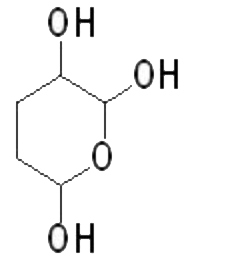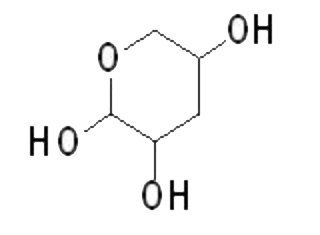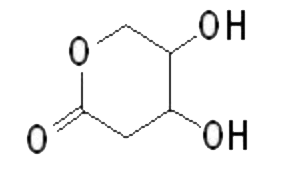In which molecule, cleavage by HIO4 is not observed?




The correct Answer is:A
To determine which molecule does not undergo cleavage by HIO₄ (periodic acid), we need to understand the mechanism of HIO₄ and the types of alcohols it cleaves.
1. Understanding HIO₄:
- HIO₄ is known as periodic acid and is an oxidizing agent. It is particularly known for cleaving vicinal diols (glycols), which are compounds that have two hydroxyl (-OH) groups on adjacent carbon atoms.
2. Identifying Vicinal Diols:
- A vicinal diol has the structure R-CHOH-CHOH-R', where R and R' can be hydrogen or hydrocarbon groups. The hydroxyl groups must be on adjacent carbons for HIO₄ to effectively cleave the bond between them.
3. Analyzing the Given Options:
- We will examine each option to see if it contains vicinal diols:
- Option A: Contains OH groups on non-adjacent carbons or lacks the necessary structure for vicinal diols.
- Option B: Contains vicinal diols and can be cleaved by HIO₄.
- Option C: Similar to Option B, it contains vicinal diols.
- Option D: Contains vicinal diols and can be cleaved by HIO₄.
4. Conclusion:
- After analyzing the options, we find that Option A does not contain vicinal diols and therefore does not undergo cleavage by HIO₄. The other options contain the necessary -OH groups on adjacent carbons that allow for cleavage.
Final Answer:
- The molecule in which cleavage by HIO₄ is not observed is Option A.
- HIO₄ is known as periodic acid and is an oxidizing agent. It is particularly known for cleaving vicinal diols (glycols), which are compounds that have two hydroxyl (-OH) groups on adjacent carbon atoms.
- A vicinal diol has the structure R-CHOH-CHOH-R', where R and R' can be hydrogen or hydrocarbon groups. The hydroxyl groups must be on adjacent carbons for HIO₄ to effectively cleave the bond between them.
- We will examine each option to see if it contains vicinal diols:
- Option A: Contains OH groups on non-adjacent carbons or lacks the necessary structure for vicinal diols.
- Option B: Contains vicinal diols and can be cleaved by HIO₄.
- Option C: Similar to Option B, it contains vicinal diols.
- Option D: Contains vicinal diols and can be cleaved by HIO₄.
- After analyzing the options, we find that Option A does not contain vicinal diols and therefore does not undergo cleavage by HIO₄. The other options contain the necessary -OH groups on adjacent carbons that allow for cleavage.
- The molecule in which cleavage by HIO₄ is not observed is Option A.
Similar Questions
Knowledge Check
Which compounds will be oxidised by HIO4?
ACH3−CH∣OH−C∣∣O−HB CCH3−OH∣CH−CH2−CH3DCH2−OH∣C∣CH2OH=O
CCH3−OH∣CH−CH2−CH3DCH2−OH∣C∣CH2OH=O
What is true of cleavage?
View SolutionWhat is true for cleavage : -
View SolutionIn mesolecithal eggs , the cleavage is :
View SolutionIn embryo,cleavage brings about
View SolutionAnisole on cleavage with HI gives:
View SolutionThe cleavage of zygote begins in
View SolutionAfter which stage cleavage stopped :-
View Solution
